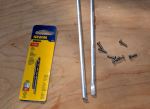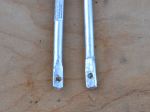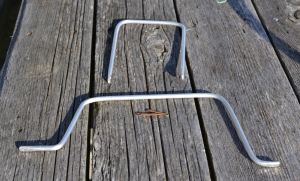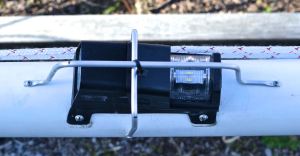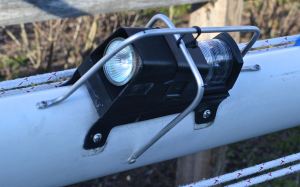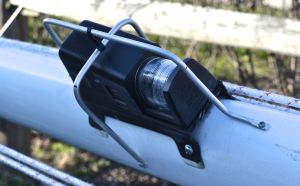This post is a mash-up of two posts that originally appeared on Windborne in Puget Sound
Say you have a boat, and say that the gelcoat has some flaws in it (but then I repeat myself). These might be caused by say, a dock that approached too quickly, or perhaps a wayward buoy inconveniently located right on your waypoint. Never fear... you don't have to live with those flaws.
Gelcoat is simply polyester resin with pigment and some flow modifiers added to it - there is nothing magic in it. The magic *is*, however, in getting the right mix of pigments so that it matches the gelcoat on your boat. You can do this (I have), but it is a truly tedious process and, for me anyway, very very challenging. Instead, I have an alternative for you.
I wonder if you knew that Fiberlay will make up a quart (minimum size) of gelcoat to match your sample. They scan the sample using not one, but three different light sources, take the average of those three results, and use that as a starting point for a manual match. You even get a custom label!
The cost is surprisingly reasonable: $73 tax included. That compares to a quart of off-the-shelf Interlux Brightsides urethane paint which pushes $50 pretty hard. Not bad at all.
Now, here's the tricky part - how do you get them a sample to scan? If you have something that can be taken off your boat that has representative gelcoat on it (a lazarette hatch for example), then you are in good shape. If not, then I hope you have saved all those plugs you cut out when installing instruments, etc.
But even failing that, for an additional charge, Fiberlay will send a technician to your boat to do the scan - but I expect that the additional charge is not necessarily trivial, skilled labor being the most expensive commodity in today's world.
Next, you will have a choice to have the gelcoat mixed up with or without wax.
Wax? Why wax?
You see, oxygen is a chain stopper for the polymerization reaction that turns liquid polyester resin into solid polyester resin. That means that the surface of a gelcoat application will not cure where it is exposed to air. When you are making a boat in a female mold, this is a good thing, insuring that the next layer to be applied will bond chemically with the uncured surface of the gelcoat. When patching this can be handy too, especially since gelcoat shrinks some while curing, and thus will likely require more than one application to a given patch.
But eventually, you will want the final layer to cure. That's where the wax comes in. If the gelcoat has wax mixed into it, the wax migrates to the surface as the cure progresses, sealing off the surface from the air and making a complete cure. This is what you would want if, for example, you were spraying gelcoat onto a finished lamination on a male mold. Or if you were willing to scrupulously dewax the surface before applying another layer of gelcoat.
I chose to have the wax left out. And I bought a small bottle of PVA (polyvinyl alcohol). This is a water soluble plastic that can be painted over the final layer of gelcoat to exclude air from the surface. A simple water rinse removes it.
So, how did it turn out? Here you go:
Yes, there is a little bit of white showing on the edge chip where I failed to remove enough of the Previous Owner's MarineTex patch. I will grind it out and apply more gelcoat. Again, a process I am way too familiar with...
But the color match is absolutely perfect! Huge kudos to Fiberlay for a match well made!
Gelcoat is simply polyester resin with pigment and some flow modifiers added to it - there is nothing magic in it. The magic *is*, however, in getting the right mix of pigments so that it matches the gelcoat on your boat. You can do this (I have), but it is a truly tedious process and, for me anyway, very very challenging. Instead, I have an alternative for you.
I wonder if you knew that Fiberlay will make up a quart (minimum size) of gelcoat to match your sample. They scan the sample using not one, but three different light sources, take the average of those three results, and use that as a starting point for a manual match. You even get a custom label!
 |
| (Pay no attention to the gelcoat smeared on the outside of the can, and don't let the can fall out of your car onto the pavement - the lid will probably come off) |
Now, here's the tricky part - how do you get them a sample to scan? If you have something that can be taken off your boat that has representative gelcoat on it (a lazarette hatch for example), then you are in good shape. If not, then I hope you have saved all those plugs you cut out when installing instruments, etc.
 |
| Always save those plugs |
Next, you will have a choice to have the gelcoat mixed up with or without wax.
Wax? Why wax?
You see, oxygen is a chain stopper for the polymerization reaction that turns liquid polyester resin into solid polyester resin. That means that the surface of a gelcoat application will not cure where it is exposed to air. When you are making a boat in a female mold, this is a good thing, insuring that the next layer to be applied will bond chemically with the uncured surface of the gelcoat. When patching this can be handy too, especially since gelcoat shrinks some while curing, and thus will likely require more than one application to a given patch.
 |
| PVA |
I chose to have the wax left out. And I bought a small bottle of PVA (polyvinyl alcohol). This is a water soluble plastic that can be painted over the final layer of gelcoat to exclude air from the surface. A simple water rinse removes it.
So, how did it turn out? Here you go:
 |
| Filling some screw holes and chips on the edge of a cockpit seat |
Looks pretty good, doesn't it? I must say that managing the gelcoat as you are applying it is difficult. Just like working with polysulphide, it seems to get on everything, including my hands, my pants, and my feet. You will want to keep a can of acetone and a rag handy.
Before I applied it to the problem areas, I used my Dremel tool to clean them up. Some were just small screw holes or chips as in the picture above, but one area needed severe remedial work. I mixed the gelcoat in a plastic cup with a tongue depressor and then used the tongue depressor to apply it. On the next batch I think I will try a paint brush for the larger areas - the stuff is pretty runny.
After it goes off, it needs to be sanded, a process I am way too familiar with from doing automotive body work. I used 220 grit wet/dry paper, wet, and I applied blue tape around the area to be sanded so that I wouldn't accidentally sand thru the gelcoat on adjacent areas. Once I had the patch down to about the thickness of the tape I switched to 400 grit, removed the tape, and sanded it flat. Then a touch of polishing with some compound, and...
 |
| Poof! Gone! |
But the color match is absolutely perfect! Huge kudos to Fiberlay for a match well made!

